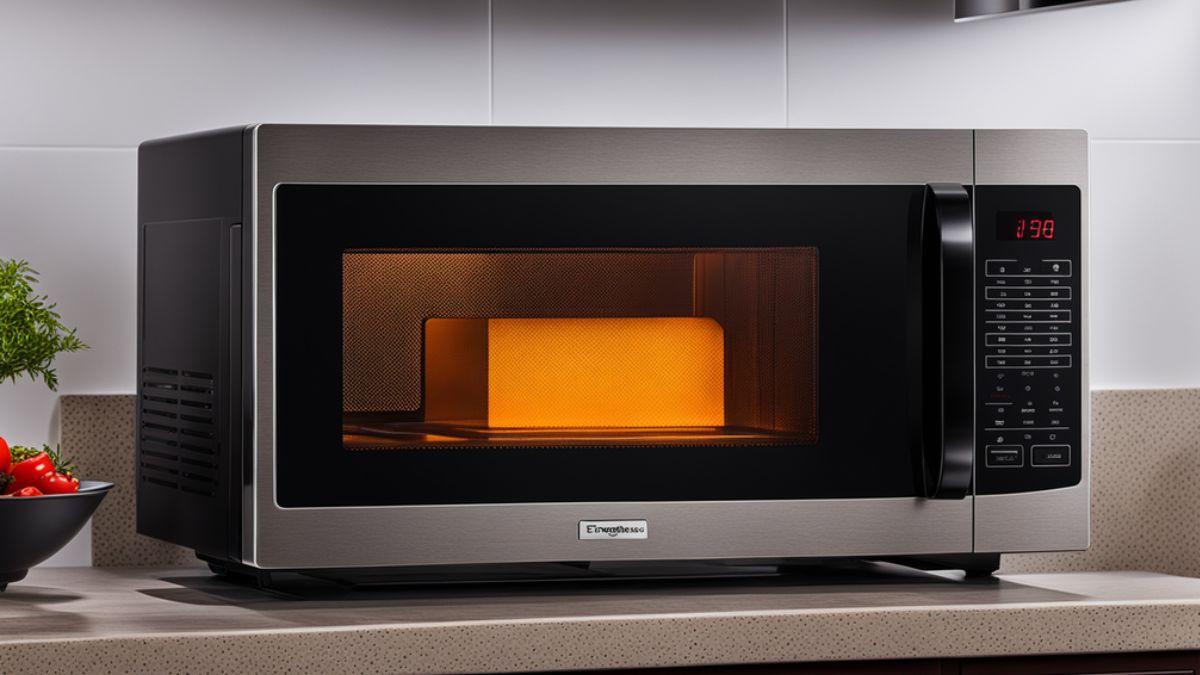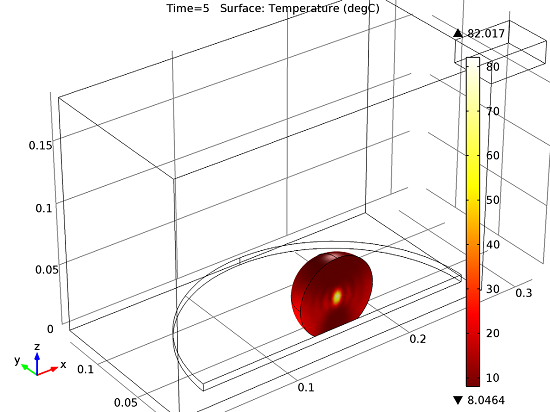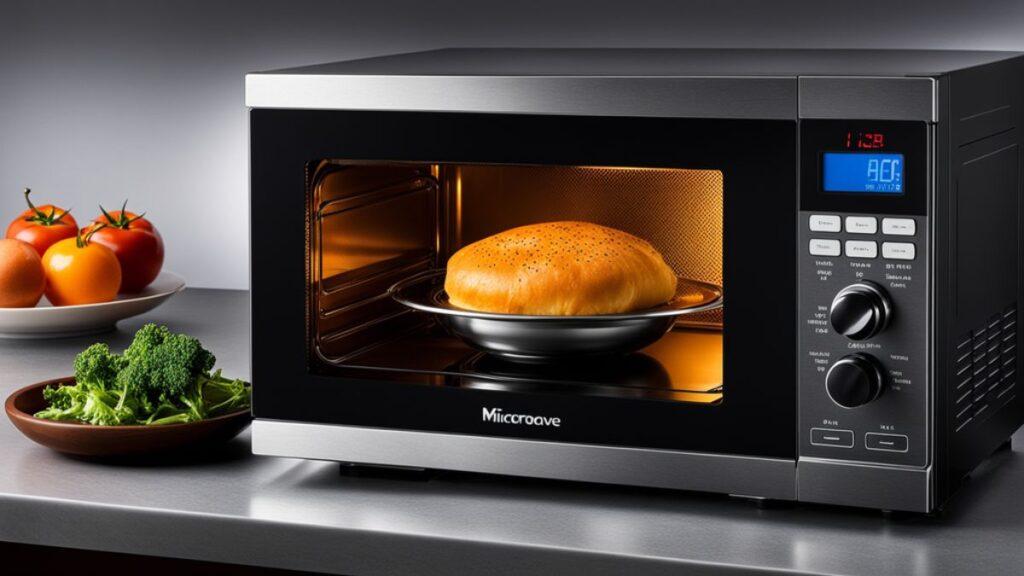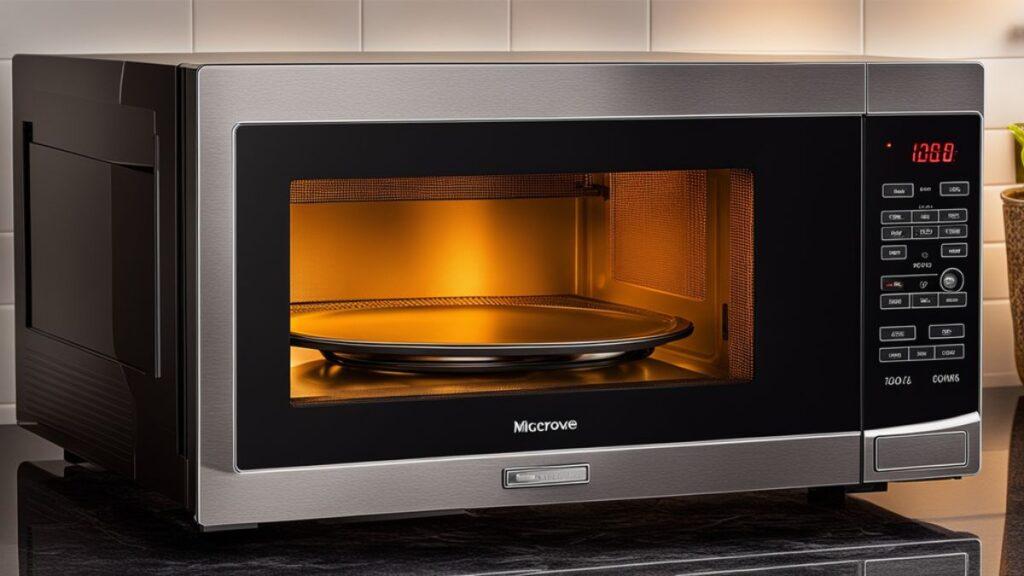
We may earn money or products from the companies mentioned in this post.
The temperature inside a microwave oven doesn’t exceed the boiling point of water at standard pressure, which is 212°F (100°C). Microwaves heat food by agitating water molecules, not by the appliance itself generating extreme heat.
Microwaves have become a staple in kitchens worldwide, providing a quick and convenient method for heating food. They work on a simple principle: they excite the water molecules within the food, causing heat through friction as the molecules vibrate rapidly.
This process heats the food relatively evenly, though sometimes unevenly, from the inside out. Microwaves do not function like traditional convection ovens; instead of heating the air around the food, they directly target the food’s molecules. The efficiency and speed of a microwave make it an invaluable tool for those needing to warm up meals or beverages in a hurry. With a variety of settings, these appliances offer flexibility, catering to different cooking requirements, from defrosting to full-power heating.
Read More: Top 5 Best Double Oven Microwave Combo for Any Budget

Credit: www.comsol.com
Heat Dynamics Of A Microwave
Understanding how a microwave heats food is fascinating. Unlike traditional cooking, a microwave uses high-frequency waves to heat water molecules within the food. Let’s dive into the unique heat dynamics of a microwave oven and see how it compares with conventional ovens.
How Microwaves Generate Heat
Microwaves operate on a simple principle. They emit microwave radiation that targets water molecules in food. These microwaves cause water molecules to vibrate rapidly, creating heat. The process efficiently heats food from the inside out, unlike traditional heating methods.
- Water Molecules: Vibrations cause friction, producing heat.
- Even Distribution: Microwaves penetrate food, offering even heating.
- Frequency: At 2.45 GHz, microwave radiation optimally heats water.
Comparing Microwave Heat With Conventional Ovens
Conventional ovens rely on thermal conduction. Heat transfer occurs from the hot exterior to the food’s cooler interior. This is slower and less efficient compared to microwave ovens.
| Aspect | Microwave Oven | Conventional Oven |
|---|---|---|
| Heating Method | Microwave Radiation | Thermal Conduction |
| Heating Speed | Fast | Slow |
| Temperature Range | Room temp to boiling point of water quickly | Up to 500 degrees Fahrenheit or more |
While conventional ovens can reach higher temperatures, microwave ovens excel at speed and energy efficiency.
- Energy Efficiency: Microwaves use less energy for the same task.
- Cooking Time: Foods cook faster in a microwave, saving time.
- User Convenience: Simpler and quicker operation in microwaves.
Read More: 2023 Best Microwave Oven Combos Reviews: Top Picks for Every Budget
Temperature Ranges In Microwave Cooking

Understanding how hot a microwave gets is crucial for cooking and reheating food safely. Microwaves generate heat by causing water molecules in food to vibrate, creating thermal energy. This process can reach various temperatures, depending on the microwave’s power and the cooking duration. Let’s explore the temperature levels you can expect with standard microwave settings.
Average Temperatures For Common Settings
Most microwaves come with preset options for different foods. Each setting is designed to reach a certain temperature range, ideal for the selected item.
- Defrost: 30-40℉ (-1-4℃) – slowly raise the temperature to thaw frozen foods without cooking them.
- Low: 100-140℉ (38-60℃) – suitable for delicate tasks like softening butter or melting chocolate.
- Medium: 140-170℉ (60-77℃) – best for simmering stews or casseroles.
- High: 170-212℉ (77-100℃) – cooks food quickly and is often used for reheating meals.
Maximum Temperatures Attainable
The peak temperature a microwave can achieve varies with wattage and time. High-powered models can reach higher temperatures faster.
| Wattage | Temperature |
|---|---|
| 600 W | 200-250℉ (93-121℃) |
| 800 W | 250-300℉ (121-149℃) |
| 1000 W+ | 300-400℉ (149-204℃) |
Note: The maximum temperature can exceed 400℉ in some high-wattage units, but it is more about how the food absorbs the microwaves rather than the air temperature within the appliance.
Read More: Can I Put My Crock Pot Insert on the Stove? Safe Use Tips
Influence Of Wattage On Microwave Heat

Do you ever wonder how hot your microwave really gets? It’s not about the heat, but the power behind it. Wattage plays a vital role in heating efficiency.
Understanding Wattage Impact
Microwaves come in various wattages, typically ranging from 500 to 1200 watts. The wattage signifies the microwave’s power capacity. Higher wattage equals greater energy emitted, heating food faster. Conversely, less wattage leads to slower cooking times. Different foods require different levels of heat and time to cook properly.
High Wattage Vs. Low Wattage Microwaves
- High Wattage Microwaves:
- Work faster – They heat and cook food quicker.
- Can reach higher temperatures in shorter time spans.
- Are suitable for cooking large quantities of food.
- Low Wattage Microwaves:
- Save energy but work at a slower pace.
- Not ideal for heating dense foods or cooking quickly.
- May heat food unevenly, requiring longer cooking times.
Read More: Unbiased Cooks Pots And Pan Reviews | Find Your Perfect Kitchen Hero
The Myth Of A Microwave ‘Heating Up’
Many people believe that their microwave oven gets hot like a traditional oven. This is a myth! Microwaves heat food, not the air inside. The truth about how microwaves work is fascinating. Let’s explore the reasons the inside of a microwave stays relatively cool and the interactions between microwaves and the materials placed inside them.
Why The Microwave Interior Stays Cool
Microwaves cook food using energy waves. These waves excite the molecules in food, which causes them to heat up. Unlike an oven, microwaves do not heat their surroundings. The interior walls do not absorb microwaves, hence they stay cool. The microwave targets food, and here’s why:
- The walls are made of metal and reflect microwaves.
- The door is designed to contain microwaves within.
- The interior does not have a heating element.
Materials And Microwave Interactions
The materials you put in a microwave affect how it works. Not all materials are microwave-friendly. Here is a quick guide:
| Material | Interaction with Microwave |
|---|---|
| Glass | Mostly microwave-safe; it lets microwaves pass through to heat food. |
| Ceramics | Usually safe unless glazed with metallic paint. |
| Plastics | Can be safe but may melt; always check for microwave-safe label. |
| Metal | Reflects microwaves; can cause sparks and should be avoided. |
Remember, every microwave is different! Always check your manual to know what’s best for your appliance. Understanding these mysteries of microwave heating will help you use your appliance more effectively and safely.
Read More: Top Cookware Companies in France – Discover Quality Kitchenware
Practical Implications Of Microwave Heat
Exploring the role of temperature in microwave ovens sheds light on their efficiency and safety. Microwaves don’t heat like traditional ovens. Instead, they use microwaves to make water molecules in food vibrate, creating heat. This unique heating method affects both cooking times and safety protocols. Let’s delve into its practical implications.
Cooking And Defrosting Efficiency
A microwave’s internal temperature doesn’t match an oven’s. It heats food by exciting water molecules, resulting in quicker cooking.
- Evenness: Rotating plates reduce cold spots, improving cooking uniformity.
- Speed: Microwaves cook food rapidly, usually in minutes, saving energy and time.
- Defrosting: With specialized settings, microwaves thaw food faster than leaving it at room temperature.
Understanding these benefits ensures efficient kitchen practices.
Safety Concerns And Heat-related Issues
Microwaves raise distinct safety concerns. Since they heat food internally, surface temperatures might deceive users.
- Container safety: Use microwave-safe containers to prevent melting and chemical leaching.
- Uneven heating: Stir food midway to avoid hotspots that can cause burns upon consumption.
- Steam buildup: Pierce or cover food to let steam escape and prevent burns or explosions.
Safety features like automatic shutoff prevent overheating, but user awareness is crucial for safe use.

Credit: cookshout.net
Temperature Control And Power Levels
Understanding Temperature Control and Power Levels is essential for microwave oven users. Different foods require different cooking temperatures. Learning to adjust the power levels can transform microwave cooking from mere reheating to culinary precision. Follow along to discover the range of cooking possibilities your microwave offers.
Benefits Of Adjustable Power Levels
- Consistent Cooking: Various power settings cater to different recipes for uniform cooking.
- Energy Efficiency: Using only the necessary power saves energy, lowering electricity costs.
- Improved Texture: Delicate dishes benefit from lower settings, retaining their ideal texture.
- Versatility: Adjustable settings allow for a range of cooking methods, from simmering to boiling.
High Heat Settings Versus Low Heat In Recipes
High heat is perfect for quick cooking and sealing flavors. It works well for:
- Heating water
- Cooking frozen foods
- Reheating meals
Low heat, on the other hand, suits delicate tasks:
- Softening butter
- Melting chocolate
- Gently cooking eggs
Using the correct power level for each recipe ensures optimal taste and texture.
Credit: www.businessinsider.com
Frequently Asked Questions On How Hot Does A Microwave Get
How Hot Does Microwave Get In 30 Seconds?
How Hot Does A 1000 Watt Microwave Get?
What Temperature Are Microwaves At?
What Is High Heat On A Microwave?
Conclusion
Understanding microwave temperatures is crucial for safe and effective cooking. Microwaves typically heat food to around 100°C (212°F), ensuring meals are hot and ready quickly. Safe usage and maintenance ensure your microwave performs optimally. Remember, knowing your appliance’s power can guide cooking times and prevent overheating.
Continue to use these insights for delicious, perfectly heated dishes every time.






